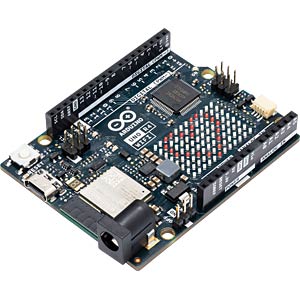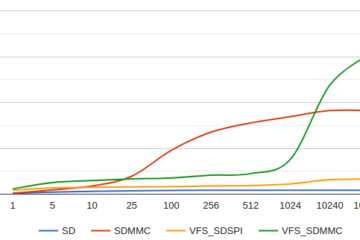In Arduino we can use the analogWrite(pin, value) method to create a PWM signal on the digital pins. The value parameter is used to change the duty cycle but the PWM frequency which is fixed at usually 490 Hz and can not be changed.

Here is a simple example sketch that also works with the UNO R4:
void setup() {
pinMode(D2, OUTPUT);
// set 100%
analogWrite(D2,255)
}
void loop() {}
Fortunately the Arduino UNO R4 provides some easy to use PwmOut class which provides more flexibility: You define the frequncy in hz and the initial duty percent. There is also a method to update the duty cycle using percent.
#include "pwm.h"
PwmOut pwm(D2);
void setup() {
//period 50us = 20000hz; pulse 0 us = 0%
pwm.begin(20000.0f, 0.0f);
// set 100%
pwm.pulse_perc(100.0f);
}
void loop() {}



17 Comments
mallori · 9. July 2024 at 17:00
This only works on pins D2 and D10… really poor since all pins of D0-D15 have a timer behind them… could we get this working ?
pschatzmann · 9. July 2024 at 17:40
I would expect that this works on any pin that has been documented to support PWM: https://docs.arduino.cc/tutorials/uno-r4-minima/cheat-sheet/
I am not doing anything with this board any more because it has not enough Flash Memory
mallori · 10. July 2024 at 8:27
I’ve done more testing. It seems it can do more PWMs, but not on the same timer. So if you use GTI0C1A pin( digital pin 2 in arduino) then you can’t also use GTIOC1B pin(digital pin 3). You can use only 1 pin per timer(GTI0C1A or B) and you can use more timers with the same restrictions. Seems like a code limitation I’d LOVE to get around because at the moment I can only use 4 timers in this manner…
mallori · 10. July 2024 at 8:45
It only works once per timer. All timers have 2 outputs, you can only use one. Did more testing to validate this. So for pins 2 and 3, for example, you can only PWM one of them with this method. Same for 4 and 5, so on and so forth.
Thita11 · 21. May 2024 at 14:04
Hi! Thank you for your helping to share the code!
I would like to ask how can I use Timer interrupt with PWM function- It is pretty slow when I drive two DC motors. with both directions.
The online code that I found is the exeption timer interrupt of UNO with PWM….
Alex · 16. May 2024 at 16:54
There is a typo in the example, it should be
pwm.begin(...)instead ofbegin(...)Andy Beer · 17. April 2024 at 14:03
As of the latest R4 PWM library update 08/04/2024, this example code generates a compile error,
“Compilation error: call of overloaded ‘begin(int, double)’ is ambiguous”
Why has this happened? Surely there should be some documentation on the effect of the library update?
pschatzmann · 20. April 2024 at 0:48
The compile error gives the relevant new method: bool begin(float freq_hz, float duty_perc);
I have updated the blog…
Andy Beer · 22. April 2024 at 12:17
Many thanks
Michiel · 12. March 2024 at 20:07
What is the highest PWM frequency of which the Arduino R4 is capable?
For the Arduino R3 I use a special-purpose library that talks directly to the timers involved so I’m no longer limited to the stated 490Hz. I have used this superb library to get as high as 50kHz for smoother running without whine and little loss of efficiency.
https://forum.arduino.cc/t/pwm-frequency-library/114988
If the Arduino R4 is similarly limited then I hope an expert will update this library to reflect the RA4M1 timers and instruction set!
Justin · 6. March 2024 at 5:03
I found your code really helpful in generating a pwm signal with the frequency and duty cycle I’m looking for but is there a way to change frequency and duty cycle while holding a button?
Felix · 1. December 2023 at 7:57
Where can i find the pwm.h libary your are using?
And does it work for all pwm-pins?
Thanks for your support!
pschatzmann · 1. December 2023 at 8:27
It’s part of the arduino core! No library is needed.
Felix · 1. December 2023 at 8:41
Thanks for your fast reply.
I’ve been using the old IDE 1.xx where it was not integrated.
But I installed the ide 2.xx now and now its working!
Jacaz · 1. July 2024 at 14:59
Thanks for share your work. In your sketch included “pwm.h”, this library no apears in Arduino Reference, could you give us more information in order to use this extended use of the pwm.
pschatzmann · 5. July 2024 at 22:25
Why don’t you just look at the header file that is part of the Arduino Core ?
https://github.com/arduino/ArduinoCore-renesas/blob/4e60678ad7286a8c74caa966e479e64c0c09de09/cores/arduino/pwm.h#L4
Amrit · 12. September 2023 at 8:45
I want to know that how can I generate Complementary PWM signal using arduino r4, I need example for both using timers and the other way if there is any..